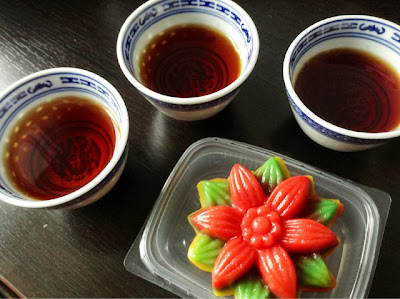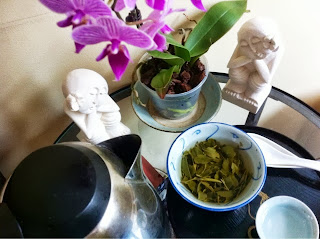It has been a full week of Obama, cameronies and lies dominating some of the world's crappiest news channels forced upon us. Add to that a persistent flu that would not go away. The solution? Brewing some twig tea, otherwise known as kukicha, a blend of stems, stalks and twigs.
Kukicha is made from Sencha. When made from Gyokuro or Matcha production, it is termed Karigane. In my case, this is a matcha karigane tea that has been carefully roasted to bring out its nutty scent and creamy sweet taste.
You will notice that the colour of a karigane infusion shares the same jade green colour with regular Sencha, yet ever so slightly lighter. In terms of taste, twig teas as a result of their composition, tend to be sweeter and less astringent. It is widely thought that the greener varieties are best steeped for less than a minute to minimise unsavoury tastes and flavours.
This matcha karigane (less green, with an overall yellowish hue due to storage) that I brewed was sufficiently sweet despite the use of just boiled water, way hotter than the recommended 80 degrees Celsius. This is most likely attributed to a two year aging process in its original packaging prior to brewing.
Sweet tea to detox the body, mind and soul. Ahhhh... now I'm ready to take on the world yet again.
Kukicha is made from Sencha. When made from Gyokuro or Matcha production, it is termed Karigane. In my case, this is a matcha karigane tea that has been carefully roasted to bring out its nutty scent and creamy sweet taste.
You will notice that the colour of a karigane infusion shares the same jade green colour with regular Sencha, yet ever so slightly lighter. In terms of taste, twig teas as a result of their composition, tend to be sweeter and less astringent. It is widely thought that the greener varieties are best steeped for less than a minute to minimise unsavoury tastes and flavours.
This matcha karigane (less green, with an overall yellowish hue due to storage) that I brewed was sufficiently sweet despite the use of just boiled water, way hotter than the recommended 80 degrees Celsius. This is most likely attributed to a two year aging process in its original packaging prior to brewing.
Sweet tea to detox the body, mind and soul. Ahhhh... now I'm ready to take on the world yet again.








